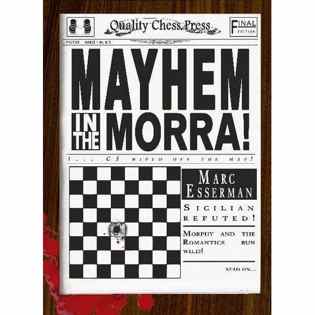Mayhem in the Morra!
Marc Esserman

When it comes to developing an opening from the ground up everyone remembers Botvinniks pioneering work in the French Winawer and Anti-Meran (5…dxc4), Polugaevskys tremendous research in the variation that bears his name in the Najdorf, and what Benko did to promote his famous gambit, but those were different times. Surely no one today could lay claim to revamping an important variation seemingly entirely by himself. Or could they?
American IM Marc Esserman in his groundbreaking Mayhem in the Morra! makes no such assertion, but rarely has one person had so much influence on reviving a variation long thought to be dead. Esserman has advocated the Smith-Morra for many years as a player and now he does so as a writer and theoretician with his Mayhem in the Morra.
Esserman, who has beaten several grandmasters in spectacular style after the sequence starting with 1.e4 c5 2.d4 cxd4 3.c3, really put him self on the map when he beat Dutch 2700 Loek Van Wely in 2011. That game, played in the U.S. Open in Orlando, began 1.e4 c5 2.d4 cxd4 3.c3 dxc3 4.Nc3 Nc6 5.Nf3 e6 6.Bc4 a6 7.0-0 Nge7 8. Bg5 f6 9.Be3 Ng6 10.Bb3 b5 11.Nd5!!. This Knight sacrifice, as Esserman explains early on in the introduction (on pages 18-19 he has 8 diagrams six with Nd5 and two with Bd5), is absolutely essential to the correctness of the Morra. White either plays it or he is worse. Time again this sharp sacrifice is the answer to many of Blacks traditional answers to the Morra.
The idea of Nd5/Bd5 is one of Essermans main contributions to the Morra while the other is the placement of Whites pieces. Back in the late 1960s and early 1970s, when Ken Smith was popularizing the gambit (by the way its pity his name was removed from the title in view of his strong role as a champion of the gambit, but to be fair his play at San Antonio 1972 did much to set it back) the autopilot approach for White was Bc4, 0-0, Bg5, Qe2, Rfd1 and Rac1. This worked well against traditional defenses but not against certain specific lines which took advantage of this lack of flexibility. Esserman wants nothing to do with the old approach. His lines sometimes see the White queen bishop going to g5 and in other instances f4 or e3. Sometimes Whites opts for an early Ng5. While Qe2 is standard in one line it goes to c2! Concrete play is the norm.
Mayhem in the Morra! is useful not only for the many new ideas and theoretical novelties it offers but also for the strategic explanations. Easerman believes the Morra is not just about cheap tricks but has a deep positional underpinning. He does an excellent job of explaining the intricacies of this opening that goes well beyond just presenting the state of theory as he sees it.
The bulk of this book is devoted to the Morra accepted but coverage of the declined is also offered. Essermans analysis of 3…d3 and 3…d5 is excellent but 3…Nf6 (which could be the subject for a separate book) is not at the depth of his work on 3…dxc3.
Mayhem in the Morra! is not an equal opportunity book. Readers will find no direct suggestions as to what Blacks best answer to the Morra is. Esserman is an unapologetic champion for 3.c3 who lives for the Morra and the language in this book reflects that. That said he is not lacking in objectivity. There are many lines that end in unclear that are playable for Black with the choice a question of taste.
The chess world is fortunate that Marc Esserman has written this book and that his first professional coach, IM Calvin Blocker, introduced him to it and encouraged him to stay the course.
Highly Recommended
Table of Contents:
Foreword by Larry Christiansen 4
Foreword by Loek van Wely 5
Key to Symbols used 6
Preface by the Author 7
Introduction The Much Maligned Morra 11
Morra Methodology 29
Morra Accepted
Chapter 1 – Siberian Wilderness 31
Chapter 2 – The Scheveningens I 57
Chapter 3 – The Scheveningens II 77
Chapter 4 – Into the Deep 97
Chapter 5 – The King in the Windy City the Chicago Defense 121
Chapter 6 – Slaying the Dragon 139
Chapter 7 – The Professionals Choice Nge7 155
Chapter 8 – Early Bishop Out Nge7 Reloaded? 183
Chapter 9 – Taylors Temple of Doom 203
Chapter 10 – Finegolds Final Frontier 233
Chapter 11 – Searching the Stars for a Refutation 245
Morra Declined
Chapter 12 – Potpourri 253
Chapter 13 – Crushing 3…d3 with the Morra-Maroczy: squeeze, squeeze, destroy! 271
Chapter 14 – The Noxious 3…Nf6 283
Appendix – Supplemental Games 313
Endnotes 345
Works Cited 348
Game Index 350
Variation Index 353
Transpositions 359
